Abstract
Trans-[Cu(quin)2(EtOH)2] (1) was synthesized as part of our study on copper(II) quinaldinate complexes with various O- and N-donor ligands. Compound 1 was characterized by infrared spectroscopy, thermal analysis and X-ray structure analysis.
1. Introduction
Copper is an essential trace element. It plays a fundamental role in our metabolism, since it is important for the structural and catalytic properties of many proteins and enzymes that are crucial for the normal growth, development and functioning of living organisms [1]. At catalytic sites, copper often participates in the electron transfer in oxidation-reduction reactions [2], exploiting a facile conversion between the oxidized +2 and the reduced +1 state. The biological role of copper is one of the main reasons for the great interest in its coordination chemistry. Copper(II) has a d9 electronic configuration. In complexes, it can be coordinated by four, five, or six donors. Due to the Jahn−Teller effect, the geometries are often distorted. Typically, the axial bonds of the octahedron are lengthened. Such a coordination pattern is known as the “4 + 2” coordination. In the extreme, the axial ligands are lost with a square planar geometry as the end result [3]. Copper(II) ions have an unpaired electron and are therefore paramagnetic [4]. According to Pearson’s classification of hard and soft acids and bases, Cu2+ ions are borderline [5]. Thus, they do not have great preferences towards donor atoms, but nevertheless oxygen and nitrogen ligands predominate [4].
Quinaldinic acid (IUPAC name: quinoline-2-carboxylic acid), shown in Scheme 1, is a structural analogue of picolinic acid (IUPAC name: pyridine-2-carboxylic acid) which has found wide use in the coordination chemistry of many transition metals [6]. Upon giving off its proton, each acid forms an anion with two functional groups, carboxylate and pyridine nitrogen which can bind to transition metal cations. Although literature abounds with the structural data on picolinate complexes, the quinaldinate complexes remain relatively rare [6]. Quinaldinate usually binds in a bidentate chelating manner, described as a 1.101 coordination mode in the Harris notation [7]. The quinaldinate is important in chemical engineering and chemical recognition due to its ability to form hydrogen bonds and π∙∙∙π stacking interactions.
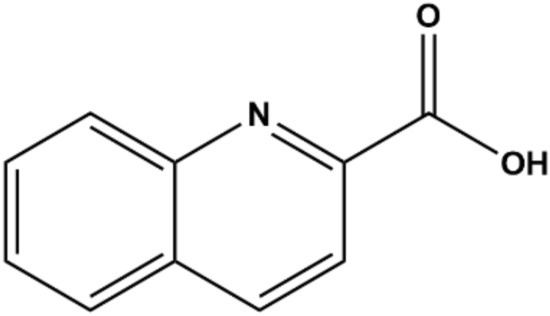
Scheme 1.
Structural formula of the quinaldinic acid, abbreviated as Hquin.
As part of our study on copper(II) quinaldinate complexes with various N- and O-donor ligands, we have prepared a heteroleptic neutral complex which contains both the quinaldinate and ethanol ligands. Herein, we report on its synthesis, X-ray structure, infrared vibrational spectrum and thermal analysis results. The quinaldinate to copper(II) ratio used in the synthesis was 1:1. With such a ratio, a rarely observed bridging coordination of quinaldinate was expected. However, regardless of the reaction conditions used, the composition of the only solid isolated from the copper(II)-quinaldinate-ethanol reaction system was [Cu(quin)2(EtOH)2] (1).
2. Results and Discussion
2.1. Description of the Crystal Structure
In the title compound, copper(II) is coordinated by two bidentate chelating quinaldinates and two monodentate ethanol molecules. The ORTEP drawing of the complex molecule is shown in Figure 1. The ligands are arranged in trans geometry and the distribution of N2O4 donors describes a distorted octahedron as a result of an operating Jahn−Teller effect [3]. The octahedron is elongated with the ethanol molecules at a relatively large distance, 2.4017(15) Å. Such a bonding pattern is described as the “4 + 2” coordination. Quinaldinate ligands are nearly planar, since the angle between the carboxylate moiety and the quinaldinate bicyclic system is 2.7(3)°. There is a short intramolecular contact between C–H of one quinaldinate ligand and coordinated carboxylate oxygen of the other quinaldinate with a length of 2.985(2) Å. The bond lengths between the copper(II) ion and the quinaldinate in compound 1 are similar to those observed in [Cu(quin)2(MeOH)]∙MeOH [8]. The Cu–N bond lengths are 2.1197(14) Å in 1 and 2.0994(15) and 2.0836(15) Å in [Cu(quin)2(MeOH)]∙MeOH, while the Cu–O bond lengths are 1.9034(12) Å in 1 and 1.9112(12) and 1.9081(12) Å in [Cu(quin)2(MeOH)]∙MeOH [8]. Only one length is given for compound 1 because the asymmetric unit contains one half of the complex molecule. The pair displays markedly different copper–to–alcohol bond lengths: the methanol complex, [Cu(quin)2(MeOH)]∙MeOH, features a much shorter bond of 2.2806(14) Å [8]. Moreover, the Cu–O bond length of 2.4017(15) Å in compound 1 is longer than the average value for bonds between copper(II) ions and O-donor atoms of alcohol molecules [9].
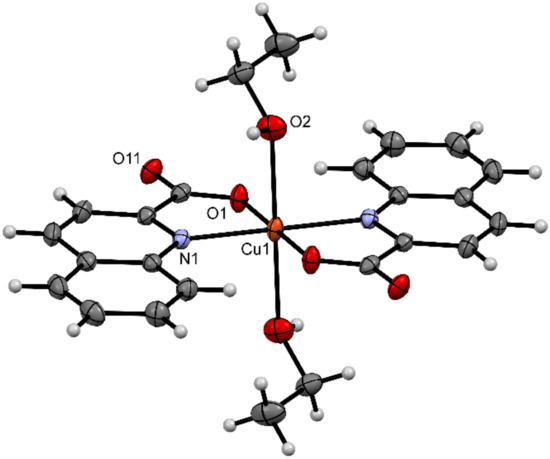
Figure 1.
ORTEP drawing of trans-[Cu(quin)2(EtOH)2] (1). Displacement ellipsoids are drawn at the 50% probability level. Hydrogen atoms are shown as spheres of arbitrary radii.
A survey of the Cambridge Structural Database (CSD) [6] revealed that few compounds with the same composition but different transition metal cations are known, namely trans-[Mn(quin)2(EtOH)2] [10], trans-[Fe(quin)2(EtOH)2] [11] and trans-[Co(quin)2(EtOH)2] [12,13]. It should be noted that the isostructural homologues exhibit significantly shorter metal-to-ethanol bonds. Interestingly, the same three metal cations display another type of compounds which also contain quinaldinate and ethanol. Their composition is trans-[M(quin)2(H2O)2]∙2H2O∙2EtOH (M = Mn2+ [14], Fe2+ [15] and Co2+ [16]). In these compounds, water molecules are coordinated instead of two ethanol ligands. The existence of the analogous copper(II) compound is not likely, since the copper(II)-quinaldinate-water system has so far yielded a different complex, [Cu(quin)2(H2O)], which features copper(II) in a five-coordinate environment [17].
2.2. Supramolecular Structure
The analysis of the crystal structure shows that only one type of hydrogen bond exists, OH∙∙∙COO−. The hydroxide groups of the ethanol molecules act as hydrogen bond donors, while the non-coordinated oxygen atoms of the quinaldinate carboxylate moiety act as acceptors. Hydrogen bonds of 2.7644(19) Å therefore linked the molecules into infinite chains which propagated along the a-axis (Figure 2). Each molecule formed four such interactions with two adjacent molecules. The hydrogen bonding pattern can be described as in graph set notation [18]. The packing revealed that each chain was surrounded by six other chains (Figure 3), but no significant π∙∙∙π stacking interactions could be observed between the quinaldinate rings [19]. The shortest Cu∙∙∙Cu contact within the chain was 5.9782(2) Å.
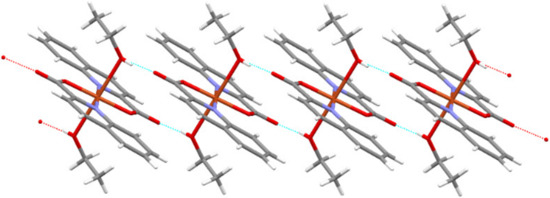
Figure 2.
A short section of a chain in the structure of trans-[Cu(quin)2(EtOH)2].
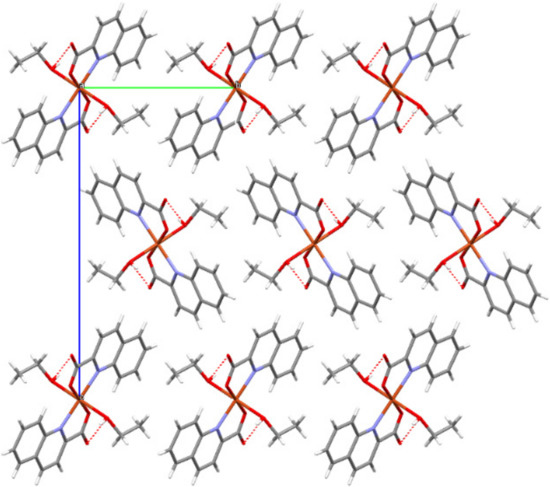
Figure 3.
A projection of the structure along a-axis showing the packing of chains.
2.3. Infrared Spectroscopy
The infrared spectrum showed the typical absorption bands of ethanol. A broad band at 3255 cm−1 can be assigned to the ν(O–H) vibration and weak but sharp bands in the range 2967–2869 cm−1 to the ν(C–H) vibrations of the methylene and methyl groups. Strong bands at 1089, 1046 and 1025 cm−1 appeared in the region of the ν(C–O) vibrations of the primary alcohols. These bands rapidly lost intensity with time as the compound decomposed outside of the mother liquor. The quinaldinate signature bands were the most intense ones in the spectrum. The bands at 1638, 1391 and 1367 cm−1 were due to the νasym(COO−) and the νsym(COO−) vibrations, respectively. The difference between the νasym(COO−) and the νsym(COO−) frequencies, i.e., 271 cm−1, agreed with the carboxylate coordination through only one oxygen atom [20]. For comparison, [Cu(quin)2(H2O)] has bands at 1631, 1372, 1344 cm−1 and [Cu(quin)2(MeOH)]∙MeOH at 1645, 1380, 1371, 1364, 1346 cm−1 [8]. For trans-[Mn(quin)2(EtOH)2] and trans-[Co(quin)2(EtOH)2] only two bands were reported, namely at 1630/1392 cm−1 and at 1626/1397 cm−1, respectively [10,12]. The infrared spectrum of compound 1 is shown in the Supplementary Materials, Figure S1.
2.4. Thermal Analysis
Compound 1 decomposed in two endothermic stages over the temperature range 20–500 °C. Upon heating, mass loss began above 80 °C and continued up to 120 °C, where the mass stabilized. In the first decomposition step, the loss amounted to 17.80% of the initial value. The experimental value roughly agrees with the calculated one for the release of two ethanol molecules per formula unit, 18.43%. The residue {Cu(quin)2} displayed a region of stability up to 260 °C, when the second major degradation process set in. By 500 °C, the mass was reduced by almost 60%. Upon further heating to about 600 °C, a slight increase in the mass of the solid residue was observed. From then on to 800 °C, a continuous decrease in mass was observed. Both the thermogravimetric (TG) and differential scanning calorimetry (DSC) curves are shown in Figure 4, while the TG-MS diagram can be found in the Supplementary Materials, Figure S2. The TG-MS diagram confirms the loss of ethanol in the first decomposition step [21].
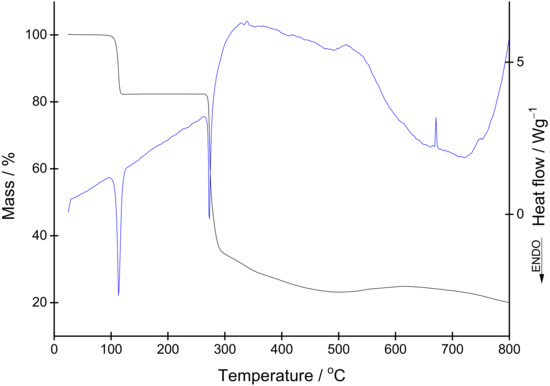
Figure 4.
TG-DSC diagram for trans-[Cu(quin)2(EtOH)2] (1).
3. Materials and Methods
3.1. General
All reagents were purchased from commercial sources and used without further purification. IR spectrum was recorded on a FTIR instrument PerkinElmer Spectrum 100 (PerkinElmer, Shelton, CT, USA) between 4000 and 600 cm−1 with ATR module. Due to the instability of compound 1, elemental CHN analysis could not be performed. For the same reason, no magnetic measurements were performed. TG analysis was carried out on a Mettler Toledo TG/DSC 1 instrument (Mettler Toledo, Schwerzenbach, Switzerland). A small amount of crystals of trans-[Cu(quin)2(EtOH)2] was carefully removed from the mother liquor, placed on a filter paper for a few seconds, and then placed in a platinum crucible. The sample was heated from 20 to 800 °C at a heating rate of 10 °C min−1. The furnace was purged with argon at a flow rate of 50 mL min−1. The baseline was subtracted. The evolved gases were analyzed using a Pfeiffer Vacuum ThermoStar mass spectrometer (MS) (Pfeiffer Vacuum ThermoStar, Asslar, Germany). Single crystal X-ray diffraction data were obtained on an Agilent SuperNova diffractometer (Agilent Technologies XRD Products, Oxfordshire, UK) with molybdenum (Mo-Kα, λ = 0.71073 Å) X-ray source at 150 K. CrysAlis PRO [22] was used for data processing and Olex2 software [23] for data analysis. Intrinsic phasing in ShelXT [24] was used for structure solution and least squares method in ShelXL [25] for structure refinement. Anisotropic displacement parameters were determined for all nonhydrogen atoms. OH hydrogen atoms of the ethanol molecules were obtained from a difference Fourier map and refined with isotropic displacement parameters. The remaining hydrogen atoms were placed in geometrically calculated positions and refined with riding models. The ethanol was disordered over two positions and the disorder was successfully modeled using the PART instruction. One conformation was refined with 0.72 occupancy and the other with 0.28. Crystal structure analysis and preparation of figures was carried out with programs Platon [26] and Mercury [27]. The crystal structure was deposited to the CCDC and assigned the deposition number 2082226. These data can be obtained free of charge via http://www.ccdc.cam.ac.uk/conts/retrieving.html (accessed on 27 May 2021) (or from the CCDC, 12 Union Road, Cambridge CB2 1EZ, UK; Fax: +44 1223 336033; E-mail: deposit@ccdc.cam.ac.uk). The crystallographic data are summarized in Table 1.

Table 1.
Crystallographic data for trans-[Cu(quin)2(EtOH)2] (1).
3.2. Synthesis
Procedure A. Copper(II) acetate hydrate (100 mg, 0.50 mmol) was dissolved in ethanol (15 mL) with stirring while the reaction mixture was kept in a hot water bath. Quinaldinic acid (86 mg, 0.50 mmol) was added to the solution. Within a few minutes, precipitation of a solid of light turquoise color occurred. The solid was filtered off and dried. Its mass was 80 mg. The turquoise filtrate was left to stand in a closed container at ambient conditions. Within two days, a small amount of needle-like crystals formed. Both the solid and the crystals were identified as trans-[Cu(quin)2(EtOH)2]. Yield: 64%. Procedure B. A Teflon container was loaded with copper(II) acetate hydrate (100 mg, 0.50 mmol), quinaldinic acid (86 mg, 0.50 mmol) and ethanol (15 mL). The container was closed and inserted into a steel autoclave, which was heated for 4 h at 105 °C. The reaction mixture was then slowly cooled to room temperature. The resulting crystals of trans-[Cu(quin)2(EtOH)2] were filtered off. Yield: 47 mg, 38%. IR (ATR, cm−1): 3255, 3105, 2967, 1638, 1597, 1566, 1511, 1464, 1434, 1391, 1367, 1346, 1272, 1206, 1188, 1154, 1089, 1046, 1025, 996, 968, 904, 886, 863, 819, 807, 777, 640, 628, 611.
Supplementary Materials
The following are available online, Figure S1: IR spectrum of 1, Figure S2: TG-MS diagram of 1.
Author Contributions
Conceptualization, B.M. and N.P.; checking the reproducibility of synthesis, J.Č.; writing, review and editing, B.M. and N.P. All authors have read and agreed to the published version of the manuscript.
Funding
This research was funded by the Slovenian Research Agency (Junior Researcher Grant for N.P. and the Program Grant P1-0134).
Data Availability Statement
Crystal structure data can be found at CCDC (deposition number 2082226).
Acknowledgments
The authors would like to thank Romana Cerc Korošec for performing thermal analysis.
Conflicts of Interest
The authors declare no conflict of interest. The funders had no role in the design of the study; in the collection, analyses, or interpretation of data; in the writing of the manuscript, or in the decision to publish the results.
References
- Linder, M.C. Biochemistry of Copper; Plenum Press: New York, NY, USA, 1991; pp. 1–13. [Google Scholar]
- Kaim, W.; Rall, J. Copper—A “modern” bioelement. Angew. Chem. Int. Ed. 1996, 35, 43–60. [Google Scholar] [CrossRef]
- Cotton, F.A.; Wilkinson, G.; Murillo, C.A.; Bochmann, M. Advanced Inorganic Chemistry, 6th ed.; Wiley: New York, NY, USA, 1999; pp. 854, 855, 864, 865. [Google Scholar]
- Conry, R.R. Copper: Inorganic & Coordination Chemistry. In Encyclopedia of Inorganic Chemistry, 2nd ed.; King, R.B., Ed.; Wiley: Hoboken, NJ, USA, 2005; Volume 1, pp. 1–19. [Google Scholar]
- Pearson, R.G. Hard and soft acids and bases. J. Am. Chem. Soc. 1963, 85, 3533–3539. [Google Scholar] [CrossRef]
- Groom, C.R.; Allen, F.H. The Cambridge Structural Database in retrospect and prospect. Angew. Chem. Int. Ed. 2014, 53, 662–671. [Google Scholar] [CrossRef]
- Coxall, R.A.; Harris, S.G.; Henderson, D.K.; Parsons, S.; Tasker, P.A.; Winpenny, R.E.P. Inter-ligand reactions: In situ formation of new polydentate ligands. J. Chem. Soc. Dalton Trans. 2000, 2349–2356. [Google Scholar] [CrossRef]
- Modec, B.; Podjed, N.; Lah, N. Beyond the simple copper(II) coordination chemistry with quinaldinate and secondary amines. Molecules 2020, 25, 1573. [Google Scholar] [CrossRef]
- Nimmermark, A.; Öhrström, L.; Reedijk, J. Metal-ligand bond lengths and strengths: Are they correlated? A detailed CSD analysis. Z. Kristallogr. Cryst. Mater. 2013, 228, 311–317. [Google Scholar] [CrossRef]
- Dobrzyńska, D.; Jerzykiewicz, L.B.; Jezierska, J.; Duczmal, M. Crystal structure and characterization of manganese(II) carboxylates: 3D metal−organic frameworks. Cryst. Growth Des. 2005, 5, 1945–1951. [Google Scholar] [CrossRef]
- Osawa, K.; Furutachi, H.; Fujinami, S.; Suzuki, M. trans,trans,trans-Diethanoldiquinaldinatoiron(II). Acta Crystallogr. Sect. E 2003, 59, m315–m316. [Google Scholar] [CrossRef]
- Żurowska, B.; Brzuszkiewicz, A. Co(II)-promoted transformation of diethyl(quinolin-2-ylmethyl)phosphonate to quinoline-2-carboxylate (2-qca): Synthetic, structural and magnetic studies of [Co(2-qca)2(EtOH)2]. Polyhedron 2008, 27, 1623–1630. [Google Scholar] [CrossRef]
- Hu, Z.-B.; Jing, Z.-Y.; Li, M.-M.; Yin, L.; Gao, Y.-D.; Yu, F.; Hu, T.-P.; Wang, Z.; Song, Y. Important role of intermolecular interaction in cobalt(II) single-ion magnet from single slow relaxation to double slow relaxation. Inorg. Chem. 2018, 57, 10761–10767. [Google Scholar] [CrossRef]
- Haendler, H.M. A manganese quinaldinate complex: Trans-[Diaquabis(2-quinolinecarboxylato)manganese(II)]-water-ethanol (1/2/2). Acta Crystallogr. Sect. C 1996, 52, 801–803. [Google Scholar] [CrossRef]
- Okabe, N.; Makino, T. trans-Diaquabis(2-quinolinecarboxylato-N,O)iron(II)-ethanol-water (1/2/2). Acta Crystallogr. Sect. C 1998, 54, 1279–1280. [Google Scholar] [CrossRef]
- Okabe, N.; Makino, T. trans-Diaquabis(quinoline-2-carboxylato-N,O)cobalt(II)-water-ethanol (1/2/2). Acta Crystallogr. Sect. C 1999, 55, 300–302. [Google Scholar] [CrossRef]
- Haendler, H.M. Copper quinaldinate monohydrate [aquabis(2-quinolinecarboxylato)copper(II)]; pentacoordinate copper. Acta Crystallogr. Sect. C 1986, 42, 147–149. [Google Scholar] [CrossRef]
- Etter, M.C.; MacDonald, J.C.; Bernstein, J. Graph-set analysis of hydrogen-bond patterns in organic crystals. Acta Crystallogr. Sect. B 1990, 46, 256–262. [Google Scholar] [CrossRef] [PubMed]
- Janiak, C. A critical account on π–π stacking in metal complexes with aromatic nitrogen-containing ligands. J. Chem. Soc. Dalton Trans. 2000, 3885–3896. [Google Scholar] [CrossRef]
- Nakamoto, K. Infrared and Raman Spectra of Inorganic and Coordination Compounds. Part. B: Applications in Coordination, Organometallic, and Bioinorganic Chemistry, 6th ed.; Wiley: Hoboken, NJ, USA, 2009; pp. 64–67. [Google Scholar]
- NIST Mass Spectrometry Data Center; William, E. Wallace, director, Mass Spectra. In NIST Chemistry WebBook, NIST Standard Reference Database Number 69; Linstrom, P.J., Mallard, W.G., Eds.; National Institute of Standards and Technology: Gaithersburg, MD, USA, 2018; p. 20899. [Google Scholar]
- Agilent. CrysAlis PRO; Agilent Technologies Ltd.: Yarnton, Oxfordshire, UK, 2014. [Google Scholar]
- Dolomanov, O.V.; Bourhis, L.J.; Gildea, R.J.; Howard, J.A.K.; Puschmann, H. Olex2: A complete structure solution, refinement and analysis program. J. Appl. Crystallogr. 2009, 42, 339–341. [Google Scholar] [CrossRef]
- Sheldrick, G.M. SHELXT–Integrated space-group and crystal-structure determination. Acta Crystallogr. Sect. A 2015, 71, 3–8. [Google Scholar] [CrossRef]
- Sheldrick, G.M. Crystal structure refinement with SHELXL. Acta Crystallogr. Sect. C 2015, 71, 3–8. [Google Scholar] [CrossRef] [PubMed]
- Spek, A.L. Structure validation in chemical crystallography. Acta Crystallogr. Sect. D 2009, 65, 148–155. [Google Scholar] [CrossRef]
- Macrae, C.F.; Bruno, I.J.; Chisholm, J.A.; Edgington, P.R.; McCabe, P.; Pidcock, E.; Rodriguez-Monge, L.; Taylor, R.; van de Streek, J.; Wood, P.A. Mercury CSD 2.0—new features for the visualization and investigation of crystal structures. J. Appl. Crystallogr. 2008, 41, 466–470. [Google Scholar] [CrossRef]
Publisher’s Note: MDPI stays neutral with regard to jurisdictional claims in published maps and institutional affiliations. |
© 2021 by the authors. Licensee MDPI, Basel, Switzerland. This article is an open access article distributed under the terms and conditions of the Creative Commons Attribution (CC BY) license (https://creativecommons.org/licenses/by/4.0/).